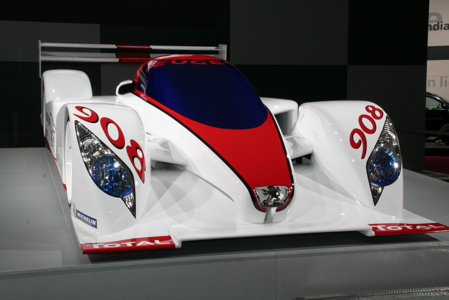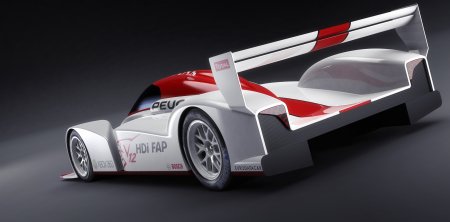
Our editor John Neff at the Paris Motor Show has snapped some shots of Peugeot's latest creation, ready to stage its attack on the 24 heures du Mans. The 908 Le Mans is a ferocious competition showcase for Peugeot's new HDi V12 also featured in the 908 RC concept sedan.
The all-aluminum 5.5-liter common-rail direct-injection twin-turbo diesel has twelve cylinders in a 100-degree V, offering a lower center of gravity. The engine produces over 700 hp in race trim, and uses an advanced particulate filter system to reduce pollution. Together with improved economy from the diesel, this makes the 908 Le Mans an exceptionally green racer. The mid-mounted longitudinal engine drives through a six-speed electro-pneumatic gearbox and a self-locking electronic differential.
The closed body-style meets new regulations and simultaneously links it aesthetically to the 905, with which Peugeot won Le Mans in both 1992 and '93. The 908 Le Mans features a monocoque construction of carbon fiber for exceptional rigidity and low weight. Dry, the 908 Le Mans tips the scales at a scant 925 kg, and measures 4650mm long by 2000 mm wide. In typical French fashion it rides on Michelin tires (and is of course painted flag-white).
Follow the jump for more pics and the press release.






 \
\















Press Release
The Peugeot 908 V12 HDi DPFS
On 14 June 2005, Peugeot announced its decision to accept a new technological challenge: to win one of the world's most prestigious and demanding motor races, the Le Mans 24 Hours, with a car powered by an HDi diesel engine equipped with a diesel particulate filter system (DPFS).
This legendary race, which every year attracts more than 200,000 spectators, will provide Peugeot with an opportunity to express fully the values enshrined in its philosophy: excellence, demonstrated by the choice of endurance coupled with reliability, dynamism, emphasised by a team challenge based on performance, looks, illustrated by the car's feline profile, and lastly innovation, expressed amongst other ways through the use of technology designed to protect the environment.
The car that will display the Peugeot colours in the Le Mans 24 Hours race and in the "Le Mans Series" in 2007 will be the Peugeot 908. The choice of number comes from, "90" designating an exceptional Peugeot model and 8 the next number in sequence after the 907 concept car.
The choice of body style is that of a closed car, in line with changes to the regulations announced by the Automobile Club de l'Ouest on 16 June 2006.
Equally there was also a desire to keep a link with the two-times winner of the Le Mans 24 Hours in 1992 and 1993, the Peugeot 905.
While from a technical point of view this solution presents a number of drawbacks (weight, height of the centre of gravity, operational problems), the Peugeot Sport team felt that it also
offers advantages, particularly in terms of chassis rigidity and aerodynamics.
The monocoque body:
The monocoque body is made of carbon and presents a truly closed structure, contrary to the 905, which was a "racing car" with a detachable tubular rollover bar. This type of
structure offers strong natural rigidity (the "eggshell" effect) and allows the weight of the monocoque body to be optimised.
Body and aerodynamics:
Created from scratch at the beginning of 2006, Peugeot Sport's aerodynamics department had the difficult task of designing in just a few weeks an exterior body that was both original
and aerodynamically efficient.
Three months after the appointment of the aerodynamics project team leader, a model of the car was undergoing the first tests in the wind tunnel!
The car's profile results not only from the necessary compromise between aerodynamic efficiency and drag, but also the need to provide optimum airflow to the different radiators
and intercoolers located within the generously dimensioned bodywork.
Suspension, steering, brakes:
Given the challenge of designing a complete car in record time and the particular constraints of the HDi DPFS engine, the Peugeot Sport team relied on proven solutions for the front and
rear suspension design, the electric power steering and the brakes.
The gearbox:
This is positioned longitudinally and will allow the fitment of up to 6 gear ratios, the limit laid down by the regulations.
It has been designed to withstand the enormous torque of the engine, while ensuring optimum weight and size characteristics.
The gearbox is controlled electro-pneumatically.
The engine:
The chosen engine architecture is a 100° V12 with a capacity of 5.5 litres.
This is the maximum capacity permitted by the regulations and was chosen due to its greater internal airflow at low engine speeds. It also gives potential future development opportunities
to use different grade fuels.
The choice of a twelve cylinder engine helps keep the cylinder bore diameter very close to that of a production series engine. In doing so, Peugeot can call on its extensive knowledge
of diesel combustion and also ensure the engine has a reasonable piston stroke. The V12 architecture, well known for its good balance, also reduces vibrations to a minimum.
The 100° V angle, like the V12 architecture, makes it possible to lower the height of the centre of gravity without affecting the engine's torsional rigidity.
Two diesel particulate filters are located at the end of each exhaust system and guarantee "smoke-free" operation of the engine under all conditions.
The two exhaust systems are as short as possible. On each side a 6 into 1 exhaust manifold is connected to a Garrett turbocharger, then to a very compact diesel particulate filter before
ending in a side exhaust pipe, located in front of the rear wheel.
The expected level of performance – a power of more than 515 kW (700 bhp) and a torque in excess of 1200 Nm, which is unprecedented for a diesel engine – is a direct results
of Peugeot's diesel engine expertise, combined with the mechanical specification of the V12 engine.
Electronics:
The 908 will benefit fully from Peugeot Sport's considerable expertise and knowledge in electronics, acquired as a result of its extensive experience with WRC cars – which are generously equipped with electronic systems – and in particular with respect to their experience of electronically controlled differentials.
Peugeot Sport will also benefit from the experience of the main supplier Bosch, who will be supplying and developing the "car system" on the basis of specifications provided by Peugeot
Sport.
A high level of performance is therefore expected in terms of "traction control", a key function for controlling engine torque in a race track environment, whilst also ensuring optimum performance of the Michelin tyres.
Technical specification of the Peugeot 908
Engine:
• Rear central longitudinal position
• All-aluminium with one-piece aluminium
cylinder block
• 12 cylinders, V angle 100°
• Capacity: 5.5 litre
• Common rail direct injection
• Engine management: Bosch MS17
• Power: 700 bhp
• Torque: 1200 Nm
Transmission:
• Gearbox: longitudinal with
a maximum of 6 gear ratios.
Electro-pneumatic gearbox control
• Differential: self-locking
Suspension, steering, brakes:
• Linked front and rear suspension
• Electric power steering
• Michelin tyres
• Wheels: BBS, magnesium
• Length: 4,650 mm
• Width: 2,000 mm
• Minimum weight: 925 kg
Peugeot's main partners in the "Le Mans Series" Championship are:
Total, Michelin, Bosch, Eurodatacar, and Xbox .


Sign in to post
Please sign in to leave a comment.
Continue